
Timely Comics is the common name for the group of corporations that was the earliest comic book arm of American publisher Martin Goodman, and the entity that would evolve by the 1960s to become Marvel Comics.
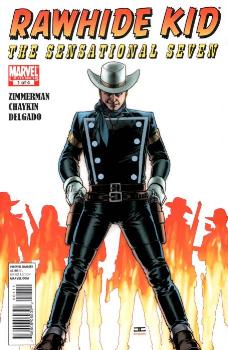
The Rawhide Kid is a fictional Old West cowboy appearing in American comic books published by Marvel Comics. A heroic gunfighter of the 19th-century American West who was unjustly wanted as an outlaw, he is one of Marvel's most prolific Western characters. He and other Marvel western heroes have on rare occasions guest-starred through time travel in such contemporary titles as The Avengers and West Coast Avengers. In two mature-audience miniseries, in 2003 and 2010, he is depicted as gay.
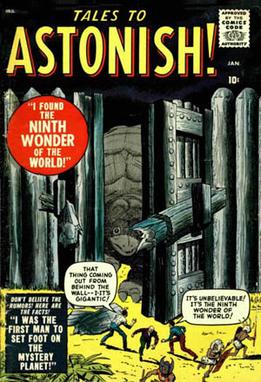
Tales to Astonish is the name of two American comic book series, and a one-shot comic, all published by Marvel Comics.

The Apache Kid (Alan Krandal) is a fictional Old West character in the Marvel Comics universe, mostly seen in stories from Marvel's 1950s precursor, Atlas Comics. This character was named after, but is unrelated to, the real-life Native American man known as The Apache Kid (Haskay-bay-nay-natyl).

Lawrence D. Lieber is an American comic book artist and writer best known as co-creator of the Marvel Comics superheroes Iron Man, Thor, and Ant-Man; for his long stint both writing and drawing the Marvel Western Rawhide Kid; and for illustrating the newspaper comic strip The Amazing Spider-Man from 1986 to September 2018. From 1974 to 1975, he was editor of Atlas/Seaboard Comics. Lieber is the younger brother of the late Marvel Comics writer, editor, and publisher Stan Lee.
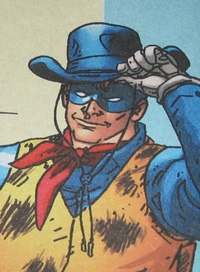
The Two-Gun Kid is the name of two Western fictional characters appearing in American comic books published by Marvel Comics. The first, Clay Harder, was introduced in a 1948 comic from Marvel predecessor Timely Comics. The second, Matt Hawk a.k.a. Matthew J. Hawkins, was introduced in 1962 and has continued to appear into the 2010s. The latter Kid is better known, thanks primarily to his connection with, and later full integration into, the shared continuity of Marvel Comics known as the Marvel Universe, but the Clay Harder Kid enjoyed a 14-year span in comics.

Richard Bache Ayers was an American comic book artist and cartoonist best known for his work as one of Jack Kirby's inkers during the late-1950s and 1960s period known as the Silver Age of Comics, including on some of the earliest issues of Marvel Comics' The Fantastic Four. He is the signature penciler of Marvel's World War II comic Sgt. Fury and his Howling Commandos, drawing it for a 10-year run, and he co-created Magazine Enterprises' 1950s Western-horror character the Ghost Rider, a version of which he would draw for Marvel in the 1960s.

The All-Winners Squad is a fictional superhero team appearing in American comic books published by Marvel Comics. The company's first such team, it first appeared in All Winners Comics #19, published by Marvel predecessor Timely Comics during the period fans and historians call the Golden Age of Comic Books.
Razorline was an imprint of American comic book company Marvel Comics that ran from 1993 to 1995. It was created by filmmaker and horror/fantasy novelist Clive Barker, with its characters existing in one of the many alternate universes outside the mainstream continuity known as the Marvel Universe.

The Ringo Kid is a fictional Western appearing in American comic books published by Marvel Comics. His comic book series was originally released by the company's 1950s predecessor, Atlas Comics. A lesser-known character than the company's Kid Colt, Rawhide Kid, or Two-Gun Kid, he also appeared in a reprint series in the 1970s.

Tower of Shadows is a horror/fantasy anthology comic book published by the American company Marvel Comics under this and a subsequent name from 1969 to 1975. It featured work by writer-artists Neal Adams, Jim Steranko, Johnny Craig, and Wally Wood, writer-editor Stan Lee, and artists John Buscema, Gene Colan, Tom Sutton, Barry Windsor-Smith, and Bernie Wrightson.

Chamber of Darkness is a horror/fantasy anthology comic book published by the American company Marvel Comics. Under this and a subsequent name, it ran from 1969 to 1974. It featured work by creators such as writer-editor Stan Lee, writers Gerry Conway, Archie Goodwin, and Roy Thomas, and artists John Buscema, Johnny Craig, Jack Kirby, Tom Sutton, Barry Windsor-Smith, and Bernie Wrightson. Stories were generally hosted by either of the characters Digger, a gravedigger, or Headstone P. Gravely, in undertaker garb, or by one of the artists or writers.
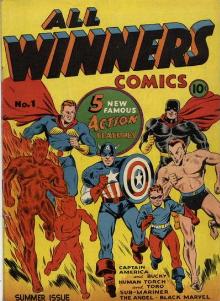
All Winners Comics was the name of two American comic book series of the 1940s, both published by Marvel Comics' predecessor, Timely Comics, during the period fans and historians call the Golden Age of Comic Books. A superhero anthology comic in both cases, they variously featured such star characters as Captain America, the original Human Torch, and the Sub-Mariner. All Winners Comics was also the venue for two full-length stories of Marvel's first superhero team, the (hyphenated) All-Winners Squad.

The Zombie is a fictional supernatural character appearing in American comic books published by Marvel Comics. The character was created by writer Stan Lee and artist Bill Everett for the standalone story "Zombie" in the horror-anthology comic book Menace #5, which was published by Atlas Comics, a forerunner to Marvel. The character later became well known for starring in the black-and-white horror-comic magazine series Tales of the Zombie (1973–1975), usually in stories by Steve Gerber and Pablo Marcos.
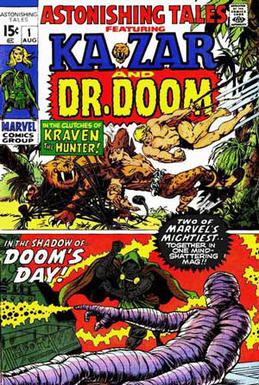
Astonishing Tales is an American anthology comic book series originally published by Marvel Comics from 1970 to 1976. Its sister publication was Amazing Adventures.
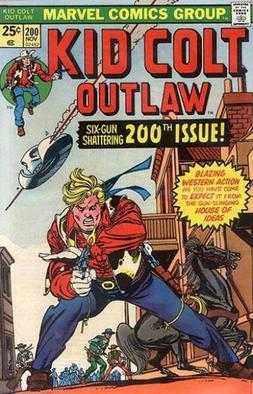
Kid Colt, Outlaw is a comic book title featuring the character Kid Colt originally published by Atlas Comics beginning in 1948 and later Marvel Comics.

World of Fantasy was a science fiction/fantasy comic book anthology series published by Marvel Comics' 1950s predecessor company, Atlas Comics. Lasting from 1956 to 1959, it included the work of several notable comics artists, including industry legends Jack Kirby, Steve Ditko, and Bill Everett.
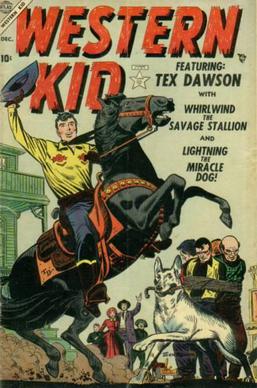
The Western Kid is a fictional Old West character appearing in American comic books published by Marvel Comics. The character was the star of Western feature published by Marvel's 1950s precursor, Atlas Comics.

The Mighty Marvel Western was an American comic book series published by Marvel Comics. A Western anthology that ran 46 issues, it consisted of reprint stories of the Marvel Old West heroes the Rawhide Kid, Kid Colt, the Two-Gun Kid, and Matt Slade, featuring much art by Jack Kirby, Jack Keller, and others. New covers, on all but three issues, were by Herb Trimpe, John Severin and Gil Kane, among others.
Two Gun Kid is the name of a comic book title featuring the character Two Gun Kid originally published by Timely Comics beginning in 1948, by Atlas Comics from 1953 to 1961, and later by Marvel Comics.


















